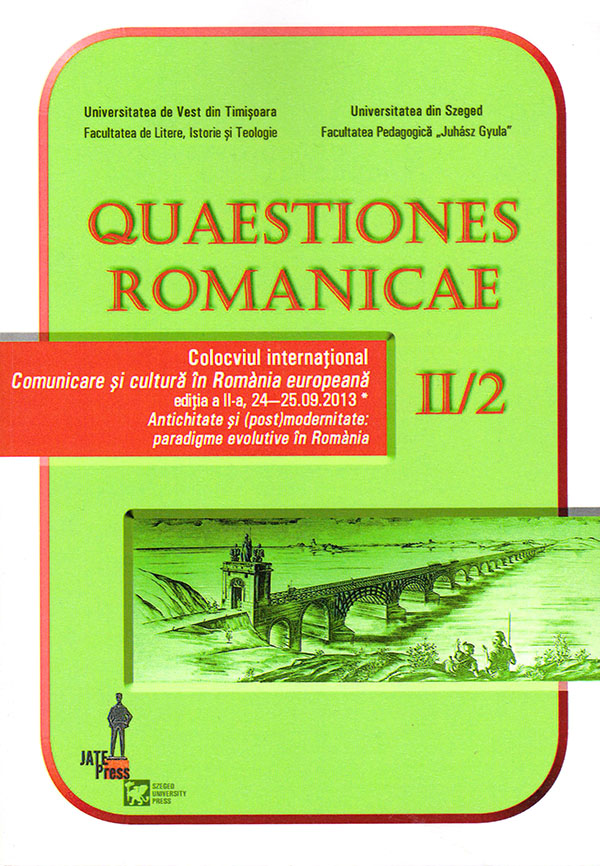Aspecte privind latinitatea autohtonilor în primul mileniu
Abstract: (Aspects concerning the Autochtons Latinity in the first Millenium A.D.) The present study investigates thoroughly the documents concerning the problem of the Latinity appurtenance of the language from the South Danube. The majority of these primary sources are connected to the Christian religion. The sources of bishop Wulphila were analized, especially those of his disciple Auxentius from Durostorum. The first, was a universal Christian, and later embraced Arianism. His disciple, casted by Teodosiu, found refuge for a bishopric centre in Mediolanum, where he wrote his work. These writings have many phonetic deviations, also morphological and of syntax found in the popular Latin spoken at the lower Danube. At the end of the 4th Century and the beginning o the 5th in Remesiana placed South of the Danube lived bishop Nicetas. Some opinions circulate in the historiography acording to which Nicetas never left the boundaries of his centre as the church rules provided. The situatian that appered in the context of Illyricum fights was also debated, a the Romans lost this territory in 437. The situation that arose till the council of Calcedon and the church rules from that period were also included in the study. The written sources like Teodoretos from Cyros (Church History), Ghenadie from Marseille (De viris illustrius), Paulinus of Nola (Letters-The Poem) contradict all the arguments of those who sustain that Nicetas was not present North of the Danube. Finally, Libelli instructiones, written in Latin by the bishop himself are all significant prooves of the fact related. Justinian`s Novella XI is quoted when the return of the Empire North of the Danube is debated. It is the only one of the 168 Latin written novellas all the rest being in Greek. The discussion is not about the Christianization of autochtonous populations but it refers to the heresy of the Bonnosians. The autochtons were already Christians. During the Avar fights, Teophilact from Simocata reminds of the words torna, torna as part of the early layers on which our language evolved. At the end of the 9thCentury Teophanes Confessor wrote torna, torna, frate By analising the works of the two authors we have discovered many examples in which Teophanes Confessor personally added some details. The conclusion, taking into consideration other interpretations, is that we have to make refferals only to Teophilact Simocata. The factors that determined The Eastern Empire to abandon Latin Christianity were also analised. After the Christianization of Boris-Michael and the reign of Simeon, Bulgaria became one factor of religious culture in the Balcans. At the North of the Danube, the basic terms concerning dogma are of Latin origin while those concerning the mass are South Slavic.
Keywords: first millennium, Lower Danube, Auxentius from Durostorum, bishop Nicetas in Remesiana, Justinian`s Novella XI, Teophilact from Simocata, torna, torna, Teophanes Confessor.
Rezumat: Studiul cercetează în amănunt izvoarele referitoare la problema latinităţii limbii de la nordul Dunării de Jos. Aceste izvoare sunt legate, majoritatea, de religia crestină. Am analizat şi scrierile referitoare la episcopul Wulfila, dar mai ales cele referitoare la discipolul sau, Auxentius din Durostorum. Primul fusese creştin universal, dar a trecut apoi la arianism. Discipolul său, alungat de Teodosiu, şi-a găsit un al doilea episcopat la Mediolanum unde şi-a redactat opera. Scrierile lui au o mulţime de abateri fonetice, morfologice şi sintactice înspre latina populară de la Dunăre. La sfârşitul sec. IV şi începutul sec. V la Remesiana în sudul Dunării a trăit episcopul Niceta. Există păreri în istoriografie comform cărora Niceta nu şi-a depăşit graniţele episcopiei în activitatea sa, aşa cum prevedeau şi canoanele bisericeşti. Am analizat situaţia în contextul luptei pentru Illyricum, pierdut definitiv de Roma în 437. De asemenea, am analizat situaţia până la Sinodul de la Chalcedon şi unele canoane bisericeşti în vigoare la acea vreme. O serie de izvoare scrise precum Theodoretos din Czros (istoria bisericească), Ghenadie din Marsilia (De viris illustrius), Paulinus din Nola (Scrisori – Poemul) tind să contrazică punct cu punct argumentele celor care susţin că Niceta nu a fost la nordul Dunării. În sfârşit, Libelli instructiones, scrise în latină chiar de episcop, sunt semnificative în acest sens. Novella XI dată de Justinian e citată când se pune în discuţie revenirea Imperiului la nordul Dunării. E însă singura din cele 168 de novellae în latină, restul fiind în greacă. Ea nu pune în discuţie creştinareaautohtonilor ci se referă la erezia bonnosienilor de care aceştia trebuie feriţi. Autohtonii erau deci deja creştini. În timpul luptelor cu avarii Teofilact Simocata aminteşte cuvintele torna, torna aparţinând celui mai însemnat dintre substraturilepe care limba noastră ş-a clădit. La sfârşitul sec. IX Theophanes Confessor a scris torna, torna, frate. Analizând operele celor doi am descoperit mai multe exemple în care Theophanes Confessor a adăugat unele amănunte cu de la sine putere. Concluzia, bazată şi pe alte interpretări, este că trebuie să facem referire doar la Teofilact Simocata. Am analizat şi factorii care au determinat Imperiul de Răsărit să nu mai fie un focar al creştinismului latinofon. În schimb, după creştinarea lui Boris-Mihail şi domnia lui Simeon, Bulgaria a devenit focar de cultura religioasă în Balcani. La nordul Dunării, termenii de bază şi privitori la dogmă sunt de origine latină, iar cei privitori la liturghie sunt de origine sud-slavă.
Cuvinte-cheie: primul mileniu, Dunărea de Jos, Auxentius din Durostorum, episcopul Nicetas de Remesiana, Novella XI a lui Iustinian, Teofilact Simocata, torna, torna, Teophanes Confessor.
